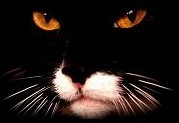|

My Breeding Concept
For nine of the past fifteen years, I have undertaken a cat-breeding program with the original purpose
of “refining” a breed of polydactyl black & white cats, otherwise referred to as "tuxedos" by many people...
and "Johnny HiHat Cats by me. No breeding has taken place for the past five years.
The goal was to develop a breed of “tuxedos” whose genotype and phenotype would correlate and
consistently replicate. However, shortly into the program, I realized that I was scrubbing down a gene pool of unknown
variety. So, my focus turned to this study.
My intent was not to start a “me-to” cattery for
fun and/or profit. Had I wished to reap immediate breeding profits, I would have acquired a tom and a few queens of
breed in demand, such as Abyssinians. After all, anyone can breed registered cats, whose pedigree assures a "type" appearance
and behavior.
Simply, as a past breeder of horses and career marketier, I have always been fascinated that while "tuxedos’"
striking appearance is very popular, especially with commercial photographers/ad agencies, “tuxes” are not organized
as a breed. They just show up in litters, as the two polydactyl “tuxes” that launched this program, did
when they were born in my barn as part of a litter of orange and grey tiger-stripes.
Further, my purpose was
to consistently produce healthy cats, in a natural process through which I would raise rugged outdoor cats, “hardycats,”
not "pussycats." At no time was my goal to perfect a deformity, such as the Twisty Cat. Polydactyls are genetically
safe and common across breeds. Additionally, no consideration was given to official registry recognition of a new breed.
I enjoy cats, but I am not a cat fancier or showperson. Again, the program has been about perfecting strong cats.
Over
the years, there have been numerous litters, each with its positive and not-so-positive outcomes; often some with great
surprises, such as the development of a true “Siamese” phenotype.
As with many scientific endeavors, planned and actual have not always correlated: While all cats share
DNA from the common parentage of a tuxedo tom and queen, there are 6 (six) distinctive “looks” on site; and with
knowledge from a failed twin-birth, that there is a steel-grey tuxedo possibility. So, rather than converging on the
tuxedo appearance of the foundation pair, the progeny have diverged. Even now, I doubt that I have scrubbed the gene
pool of all it distinctive looks. Certainly size, conformation, muscle development, coat, eye color varies thoughout. Few
cats are truly alike.
In truth, not all of the cats APPEAR to be animals that I would breed either for "type" or temper."
However, as I have discovered, when the cats randomly -- but genetically correctly -- mated with one-another from the pool,
the progeny often has been more impressive than either parent. For this reason, I have retained all the cats and held
them “whole” for possible future breeding.
Moving forward, with scientific genetic analysis -- which I am not equipped to perform -- I foresee the lesser
cats being "cataloged" for study, neutered, and thereafter put up for adoptions on an ongoing basis.
Equally as important during this period, I have also observed the communal / societal nature of the cats and
the nuances of their behaviors. Through this observation, generally held concepts regarding behaviors have often been
dismantled.
To date, there has been an investment of over $50,000 in this program. Additionally, I
have provided 100% of the effort and care. The hours are incalculable as have been the rewards.
|
|
| |
I certify that all cats either have come from or are descended from one tom and one queen. The queen recently died
at the age of 17. Though buried, her remains are available for study. The foundation tom is alive.
• Neither the tom or queen, nor any progeny have been out of the cattery.
• All breeding has
been among the generations as planned.
• In some lines, there is breeding down three and four levels.
• Not
all male cats have been bred. nor have all females.
• There remains many unknown genetic combinations.
• There
remains five of the six lines to “perfect.”
|
|
|

